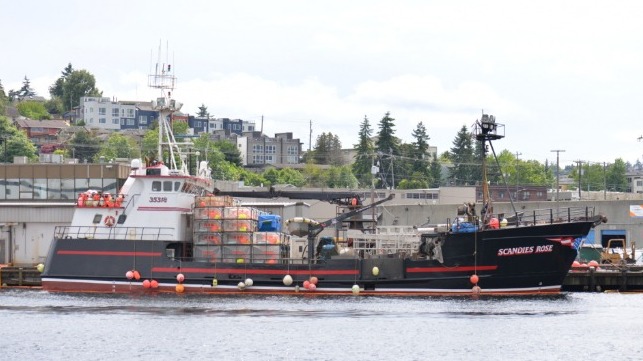NTSB Issues Report on the Sinking of the Scandies Rose

The National Transportation Safety Board has completed its investigation into the loss of the fishing vessel Scandies Rose off Sutwik Island, Alaska on New Years' Eve 2019.
While she was under way from Kodiak, Alaska, to her fishing grounds in the Bering Sea, Scandies Rose encountered unexpectedly severe weather. Shortly after making a mayday call, she capsized suddenly and went down. Out of the seven crewmembers aboard, only two were rescued by the U.S. Coast Guard. The five others were never found.
According to the NTSB, Scandies Rose likely accumulated 6-15 inches of ice on surfaces exposed to wind and icing during the voyage. The added weight from ice accumulating on one side of the vessel - plus the stacked crab pots on deck - raised the Scandies Rose’s center of gravity, reducing her stability and contributing to the capsizing.
Although the crew loaded the Scandies Rose in accordance with the stability instructions on board, the instructions were inaccurate, NTSB found. As a result, the vessel did not meet stability criteria and was more susceptible to capsizing.
The NTSB determined the probable cause of the accident was the inaccurate stability instructions for the vessel, which resulted in limited ability to resist capsizing. In addition, NTSB cited the heavy, asymmetric ice accumulation on the vessel due to weather conditions that were much more extreme than forecasted. Mariners interviewed during the investigation reported that the area around Sutwik Island was notorious for severe conditions, but the nearest weather station is located more than 100 miles from the site of the casualty, giving forecasters a limited view into the real conditions in the region.
NTSB ruled out human factors and vessel maintenance in its investigation into the probable cause. It determined that there were no indications that the captain’s predeparture decision-making, operational pressures, fatigue, drug and alcohol use, the vessel’s mechanical systems or hull integrity played any role in the casualty.
The NTSB issued seven recommendations to the Coast Guard, NOAA and fishing vessel operators. Its report calls for more accurate stability instructions that realistically consider the effect of icing on crab pots; a review of the accuracy of stability booklet calculations for the uninspected crab boat fleet; better stability training for commercial fishing crewmembers; and a requirement for personal locator beacons (PLBs) for all crewmembers.
“Commercial fishing is one of the most dangerous occupations in America, but it does not need to be,” said Chairman Robert L. Sumwalt. “The safety recommendations we issued and reiterated today, if implemented, will make commercial fishing vessels safer and will help mitigate the risks fishermen face in this occupation.”
Commercial fishing vessels are largely uninspected, and they are an area of focus for the NTSB. The agency called for new standards to address intact stability, subdivision and watertight integrity in smaller commercial fishing vessels of up to 79 feet long. Many fishing crews are not fully trained in stability management techniques or emergency response, according to NTSB.
